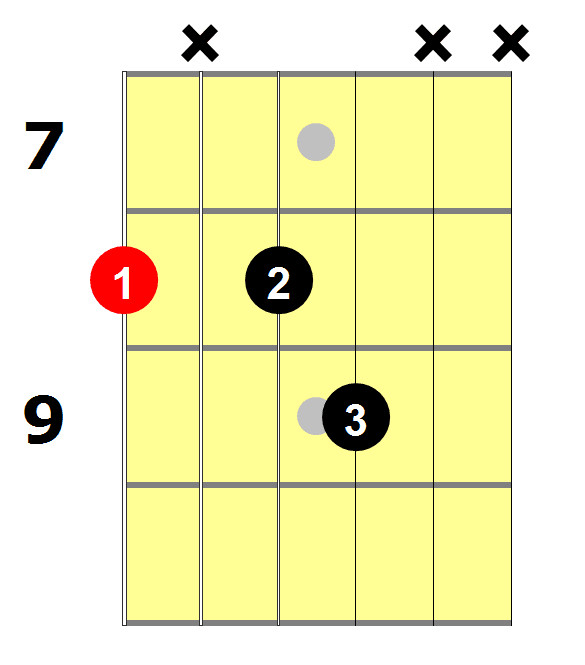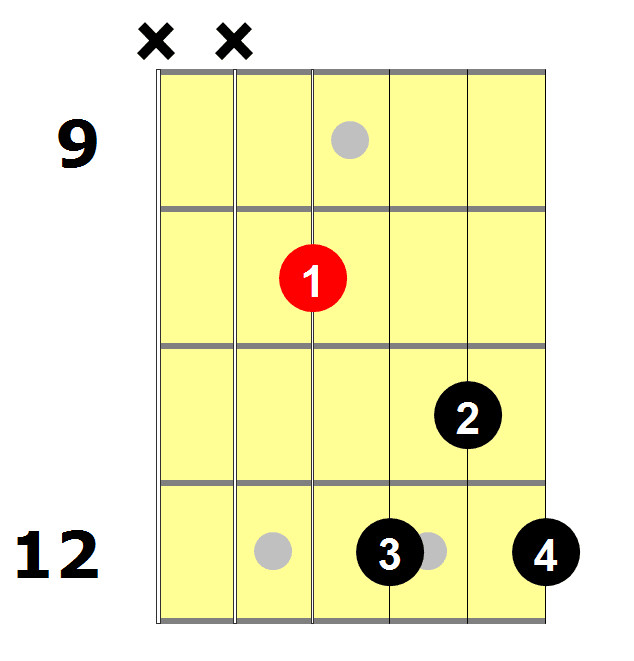The C7 guitar chord is a fantastic addition to any guitarist’s repertoire. It injects a bluesy, soulful flavor into your playing, setting it apart from the standard C major chord. Whether you’re just starting your guitar journey or looking to expand your chord vocabulary, understanding and mastering the C7 is a valuable step. In this comprehensive guide, we’ll explore five essential ways to play the C7 guitar chord, along with practice tips and song examples to help you truly master this versatile chord.
What is a C7 Guitar Chord?
Before diving into finger positions, let’s understand what makes a C7 chord unique. The ‘7’ in C7 signifies a ‘dominant 7th’ chord. This means it includes an added note, the minor seventh, which gives it that characteristic bluesy and slightly dissonant sound compared to a regular C major chord.
Let’s break down the notes:
-
C Major Chord Notes:
- Root – C
- 3rd – E
- 5th – G
-
C7 Chord Notes:
- Root – C
- 3rd – E
- 5th – G
- b7 (minor 7th) – Bb
The only difference is the addition of the Bb note. This single note transforms the bright, major sound of a C chord into the richer, more complex sound of a C7.
5 Essential Ways to Play the C7 Guitar Chord
Here are five distinct voicings of the C7 guitar chord, ranging from beginner-friendly open positions to more advanced barre chord shapes.
1. Open C7 Chord
This is often the first C7 chord that beginners learn, and for good reason. It’s relatively easy to fret and utilizes open strings, making it sound full and resonant.
- Place your 3rd finger on the 3rd fret of the A string (5th string).
- Place your 2nd finger on the 2nd fret of the D string (4th string).
- Place your 4th finger on the 3rd fret of the G string (3rd string).
- Place your 1st finger on the 1st fret of the B string (2nd string).
- Strum from the A string (5th string) downwards.
 Open C7 Guitar Chord
Open C7 Guitar Chord
This open C7 is perfect for strumming and is commonly used in folk, blues, and country music.
2. C7 Guitar Chord (E7 Barre Shape)
Barre chords are fundamental for guitarists, allowing you to play a chord shape anywhere on the neck. This C7 shape is derived from the open E7 chord, making it a moveable and versatile voicing.
First, let’s visualize the open E7 chord shape:
Now, transform it into a C7 barre chord:
- Barre your first finger across ALL strings at the 8th fret.
- Place your 3rd finger on the 10th fret of the A string (5th string).
- Place your 2nd finger on the 9th fret of the G string (3rd string).
- Strum from the low E string (6th string) downwards.
This shape essentially takes the E7 formation and moves it up the neck to the 8th fret, using the barre to replace the nut and create the C root note. Barre chords can be challenging initially, but mastering them unlocks a world of chord possibilities across the fretboard.
3. C7 Guitar Chord (A7 Shape)
Another useful barre chord shape for C7 is based on the open A7 chord. This voicing offers a slightly different tonal color and can be easier to fret for some players.
- Barre your first finger from the 3rd fret of the A string (5th string) to the high E string (1st string).
- Place your 3rd finger on the 5th fret of the D string (4th string).
- Place your 4th finger on the 5th fret of the B string (2nd string).
- Strum from the A string (5th string) downwards.
For a slightly simplified version of this shape:
- Place your 2nd finger on the 3rd fret of the A string (5th string).
- Place your 1st finger on the 2nd fret of the D string (4th string).
- Place your 3rd finger on the 3rd fret of the G string (3rd string).
- Strum from the A string (5th string) downwards.
This variation is very similar to the open C7 chord we started with, but positioned higher up the neck, offering a brighter tone.
4. C7 Guitar Chord (3-Finger Version)
This voicing is perfect for adding a low-end punch to your rhythm playing. It utilizes the lower strings and creates a gritty, powerful C7 sound.
- Place your 1st finger on the 8th fret of the low E string (6th string).
- Place your 2nd finger on the 8th fret of the D string (4th string).
- Place your 3rd finger on the 9th fret of the G string (3rd string).
- Strum from the low E string (6th string) downwards, potentially skipping the A string for a tighter sound.
This chord shape can be tricky for beginners due to the string skipping and finger stretch, but it’s worth practicing for its unique sonic character.
5. C7 Guitar Chord (D7 Shape)
This C7 voicing is derived from the D7 chord shape and is part of the CAGED system, a valuable framework for understanding guitar chords and the fretboard.
Let’s recall the D7 chord shape:
Now, transform it into a C7 chord:
- Place your 1st finger on the 10th fret of the D string (4th string).
- Place your 3rd finger on the 12th fret of the G string (3rd string).
- Place your 2nd finger on the 11th fret of the B string (2nd string).
- Place your 4th finger on the 12th fret of the high E string (1st string).
- Strum from the D string (4th string) downwards.
 C7 Guitar Chord D7 Shape
C7 Guitar Chord D7 Shape
This shape demonstrates how chord shapes can be moved and adapted across the neck, a core concept of the CAGED system.
6. C7 Guitar Chord (G7 Shape)
Often used in funk and soul music, this C7 voicing has a tight, vibrant sound that cuts through the mix. It’s a partial barre chord, requiring precision and control.
- Barre your first finger across the 5th fret, covering the D string (4th string) to the G string (3rd string).
- Place your 2nd finger on the 6th fret of the high E string (1st string).
- Strum from the D string (4th string) downwards.
This chord is economical in its finger usage but requires accurate barre placement to ring out cleanly.
Practicing Your C7 Guitar Chords: Effective Techniques
Learning new chords is one thing; making them sound smooth and effortless is another. Here are four effective practice techniques to help you truly master your C7 guitar chords.
1. Engage Muscle Memory: The Squeeze Technique
Whenever you successfully form a C7 chord, gently squeeze your fretting hand for a few seconds. This simple action helps engage muscle memory, reinforcing the physical shape of the chord in your hand. Crucially, ensure the chord is correct before you squeeze, otherwise, you risk memorizing an incorrect finger placement.
How to ensure your chord is correct?
- Visual Check: Use chord diagrams to verify your fingers are in the right positions.
- Listen for Clarity: Strum each string individually to ensure every note rings out clearly without buzzing or muting.
- Relaxation Check: Your hand should be relaxed, not tense. Pain is a signal to adjust your technique.
2. Test Yourself: Play Without Looking
A true test of chord mastery is playing it without visual assistance. This exercise sharpens your muscle memory and fretboard knowledge.
Follow these steps:
- Choose one C7 chord shape to focus on.
- Play it correctly, ensuring it sounds clean.
- Squeeze your fretting hand five times to reinforce the shape.
- Remove your hand from the fretboard.
- Look away from your guitar, perhaps focusing on a point across the room.
- Attempt to play the C7 chord again from memory.
- Check your accuracy. If correct, great! Repeat with another C7 shape. If incorrect, revisit steps 1-7 until you get it right.
3. Smooth Transitions: Chord Changes Practice
Being able to switch smoothly between chords is vital for fluid playing. Practice transitioning between different C7 voicings to improve your dexterity and chord changes.
Start by practicing ascending through the C7 chord shapes:
- Open C7
- C7 (A7 shape)
- C7 (G7 shape)
- C7 (3-finger version)
- C7 (E7 shape)
- C7 (D7 shape)
Once comfortable ascending, practice descending in reverse order. This back-and-forth practice enhances your muscle memory and fretboard navigation.
4. Musical Application: Learn Songs with C7 Chords
The most engaging and effective way to solidify your chord skills is to use them in a musical context. Learning songs that feature the C7 chord not only makes practice more enjoyable but also helps you understand how the chord functions in real music.
Songs That Feature the C7 Guitar Chord
The C7 chord is a staple in various genres, particularly blues, rock, and soul. Here are a few classic examples of songs that prominently feature the C7 chord:
1. C Blues
The 7th chord is a cornerstone of blues music. Learning a 12-bar blues progression in the key of C is an excellent way to immerse yourself in the sound and usage of the C7 chord. A standard 12-bar blues in C often includes C7, F7, and G7 chords.
2. ‘Hey Jude’ by The Beatles
This iconic Beatles hit extensively uses the C7 chord, adding a touch of harmonic richness to its famous progression. The main chord progression in ‘Hey Jude’ features C, F, C7, and G.
 Hey Jude Chords
Hey Jude Chords
3. ‘Mustang Sally’ by The Commitments (Wilson Pickett)
A blues and soul classic, ‘Mustang Sally’ is packed with C7 chords, making it a fantastic song for practicing this chord in a rhythmic and dynamic context.
Conclusion
The C7 guitar chord is more than just a variation of the C major chord; it’s a gateway to a richer, more expressive sound. By mastering these five essential shapes and employing effective practice techniques, you’ll unlock the full potential of the C7 chord and enhance your guitar playing across genres. Experiment with substituting C7 for C whenever you encounter it in songs – you’ll be surprised how much bluesy flavor it adds! Keep practicing, explore songs that utilize C7, and enjoy the journey of mastering this essential guitar chord.
Want to take your guitar journey further? Join our community for personalized learning plans, world-class courses, and a supportive network of guitarists! Click here to explore National Guitar Academy Membership
Ready to show off your guitar passion? Check out our cool guitar t-shirts and merchandise! Click here to visit our merch store

